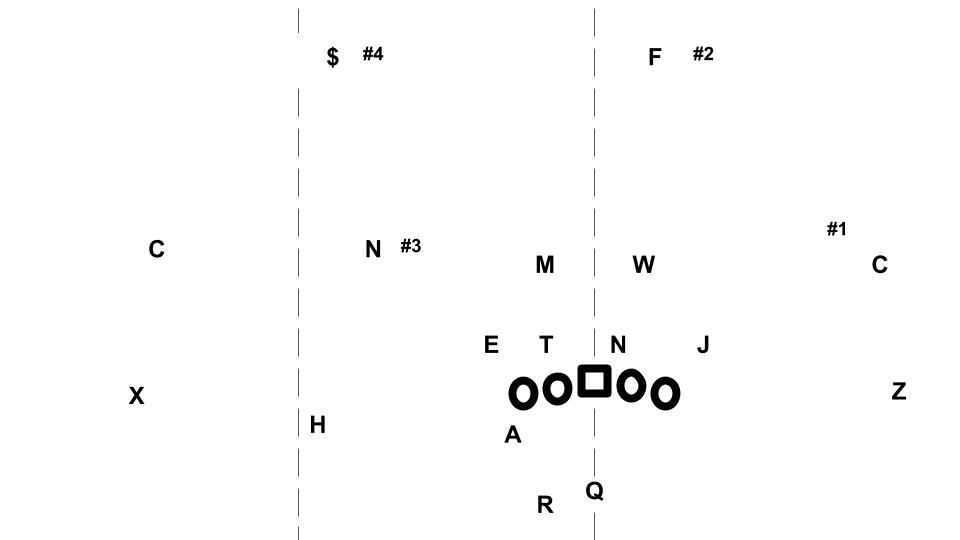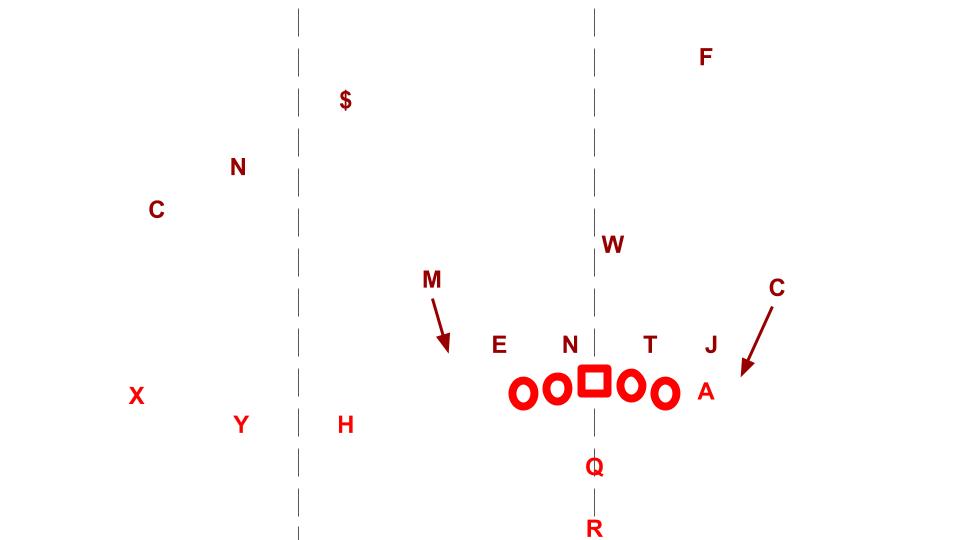I took in some of the details from the Oklahoma games this week, watching Oklahoma vs Houston with an eye for what Alex Grinch did and then surveying the tactics that led to OSU running for 352 yards.
One of the jarring observations that you couldn’t help but have when closely watching the Sooners and Cowboys this last weekend is how different their QB play was from what we’ve seen this decade. It’s easy to get caught up in the ultra-efficient passing stats exhibited by Jalen Hurts and Spencer Sanders but neither of these guys will be confused with Baker Mayfield, Mason Rudolph, or Kyler Murray for their work from the pocket. Both of them did a ton of their damage on screens and play-action shots, not from getting through progressions.
They’ll both grow as time wears on, Spencer Sanders in particular may be a very different player in two years at OSU than he is now. But both teams also played a lot with option schemes and double TE/FB sets.
The math and geometry at play
It’s often helpful to remember that football can be distilled as a game of physics and geometry. Defenses like to outnumber the run in the college game and get a defender for every gap and one more than you have blockers.
When teams play in everyone’s favorite “spread-I” sets with an off-ball TE/FB “ancillary” and then three receivers, the defense can bring an extra defender from a variety of angles. They can bring as many as four guys as the extra defender, which options #2 and #3 as the common preference:

But when an offense plays with two blockers on the field, they restrict the defense’s options for outnumber the rushing attack. For instance, check out this set by Oklahoma State:
The ‘Pokes are running power from a double ancillary (or Cowboy backs, as they call them) set. Oregon State can get extra help from the nickel, the boundary corner, or the free safety. Only three options now, and one of them HAS to get involved to account for the extra gap before you start getting extra hats on defense.
Their nickel plays it really conservatively for whatever reason but then Oklahoma State leaves the boundary corner unblocked and that proves to set a ceiling for the success of the play, particularly when they don’t blow a hole through the line with all the mass they throw at the point of attack.
You can still throw RPOs and play-action from formations with two ancillary blockers, if anything it’s even more likely that the receivers can avoid attention from bracket coverage because the DBs are needed to stop the run. The offense also has a tougher time though creating leverage down the field because there are fewer receivers to hold the attention of the good DBs.
OU did a lot of their damage from these sets by throwing to the TEs on play-fakes and rollouts, utilizing their blocking to help them get open down the field. That’s the classic method and it’s one that Boise State leaned on back in the day.
Oklahoma State’s new wrinkles
The Cowboys predictably had a little fresh variety to their run game, that’s going to happen when you hire a new OC and then an OL coach like Charlie Dickey. The latter’s fingerprints were all over some of the changes, which included a sweep play:
The assumption that opposing DCs are going to need to make when facing OSU this season is that every standard down formation is serving to create space for their run game. When he’s throwing to a pre-snap read because he knows he has a screen or Tylan Wallace has leverage, Spencer Sanders looked pretty accurate and dangerous…
…but those actions tended to come off leverage created by the run game. Oregon State wanted to use option #2 here for outrunning the spread-I run game, that left the corner a bit isolated and vulnerable to Sanders and Wallace working him over with the double move.
Beyond this, the Pokes ran some power like Dickey used to do at K-State with the pulling guard moving until he found a defender to block, and then they ran some different inside and outside zone-read schemes with the read coming on different defenders. Tricky stuff.
Teams will need to figure out how to stop OSU’s run game from finding space without giving up easy reads and throws to Tylan Wallace. Pretty tough but doable. This is exactly the sort of offense that I spent the offseason arguing that TCU could use to win 10 games if they could find a QB to execute it. OSU can run that offense, their issue is that they don’t have a D of TCU’s caliber.
Alex Grinch’s run-stopping gambit
The primary strategy that Grinch utilized to thwart Houston’s offense early in the game (later on they adjusted) was to a few different defenses that typically amounted to running mostly Okie fronts.
I know that’s confusing because this is Oklahoma but the front they tended to play was indeed the 3-4 “Okie” that plays out like a 5-2 against the run.
Grinch was utilizing a similar principle right off the bat against the Cougars. Check out how they lined up and responded to Houston’s early probings with untraditional spread sets.
The motion gave up the game but D’Eriq King didn’t know what to do with it. You’ll notice that nickel Boo Radley doesn’t chase the slot WR in motion but instead the SS comes down to handle that. That meant that the Sooners had Radley playing free on the edge as an overhang, which allowed them to outnumber the zone-read game.
DE takes the RB and the nickel stays on the QB without being put into run/pass conflict because the strong safety plays the receiver in man. It took Houston a while to figure out how to run their zone-read plays without Ronnie Perkins or another defender crushing it.
Alex Grinch used a few different methods to ensure that his defense had two over-hangs, like in a 3-4 “Okie” defense, even when facing trips sets:
Now Murray is an overhang with the corner while Radley is out wide. It’s not really a 5-2 here but more of a 5.5-1.

Radley-Hiles wasn’t brilliant as a force player on the edge but he at least knew where to be. The bigger problems for the Sooners came from their lack of leverage on the perimeter in this look…
…or their play in the box with Murray on the edge and especially when some of their back-up DL were in.
As you can see, once Holgorsen figured it out he was able to dial up some plays to land damage on the Sooners. But King could never land the deep shots that would have lit up the scoreboard and undone the structure, so the Sooners prevailed by a nice margin.
To my eyes Ryan Jones was the better compatriot for Kenneth Murray in these schemes than Dashaun White. He played a little faster and he has outstanding lateral range. If I were a Sooner though I’d be concerned about how these sets always have Murray on the edge and then one of the less experienced LBs trying to clean up as the sole 2nd level defender.
This could be a useful scheme for defending the Oklahoma State offense IF they can do it without giving up space and easy reads to throw to Sanders. Against teams like Texas Tech, Texas, or Iowa State I don’t think it’s a great idea. It defers a lot of stress to the secondary, which isn’t where you want be stress-tested in the Big 12, and it asks a lot of the weak inside linebacker where the Sooners are pretty young and unproven. It definitely gave them a boost though against Houston.
This is the sort of spread run D wizardry that defensive coordinators often show off before being invited to the Big 12 where they find out that it’s a different ball game. It’ll be interesting to see what Grinch has in store for Texas Tech in a few weeks when they have to worry more about the pass and shoring up the back end.
********
Read more on how Oklahoma has evolved in terms of using and defending spread tactics over the last two decades in my new book:









When Lsu puts a spy on Sam Ehlinger how do you think Texas will respond?
Throwing the ball around on a squad with one fewer defenders with eyes on a receiver.
Teams don’t spy Ehlinger often, maybe on 3rd down it’d be useful be he doesn’t rely on his scrambling in the passing game. He’ll happily take the extra time to find a WR.
Daily Bullets (Sept. 6): Lots of Ceiling/Floor Talk for 2019 Cowboy Football - Big 12 Blog Network
[…] Teams will need to figure out how to stop OSU’s run game from finding space without giving up easy reads and throws to Tylan Wallace. Pretty tough but doable. This is exactly the sort of offense that I spent the offseason arguing that TCU could use to win 10 games if they could find a QB to execute it. OSU can run that offense, their issue is that they don’t have a D of TCU’s caliber. [Concerning Sports] […]
Not sure that Texas Tech will be as up to testing the OU secondary as they would have been with last year’s offense. Even UTEP with its mediocre defensive backs was able to match up fairly well in man coverage with no receivers capable of punishing single high safety or zero coverage looks. Donta Thompson (or Koontz when they play him) can easily be handled by a linebacker in coverage. I think OU could run out this look on defense and have enough success slowing us down to outscore us by 14+ points.